Top News

February 13, 2015 Ryukyu Shimpo
The government of Japan is building U.S. helipads within the Northern Training Area (NTA) near Takae to return a part of the training area to landowners based on an agreement between Japan and the United States. Local citizens have been protesting against the construction because they fear it will badly influence their livelihoods and natural environment.
Tim Kao, the camp commander of the NTA said some of the protestors were not actually passionate about the cause but were, “just there because they are getting paid to be there.” His claim, revealed to the media on February 12, runs counter to the truth.
Meanwhile, Capt. Caleb D. Eames, deputy public affairs officer for the Marine Corps Installations Pacific, also made a false and inappropriate comment.
He said reports of Henoko protesters being injured due to excessive force used by Japan Coast Guard officers were “laughable.” These remarks show that disregard for Okinawa’s legitimate objection to democratically opposed base construction is prevalent among top officials of the U.S Marine Corps in Okinawa.
Kao’s remark was made on February 5 in front of N 4 gate where one of the new helipads is located. He spoke to Masayuki Tamaru of the Association of Residents Against the Helipad, and Stockholm University graduate Mattias Karnell.
According to Tamaru and Karnell, Kao claimed some citizens involved in the protest get paid by “elements in Tokyo” and are not actually passionate about the cause.
Tamaru denied the claim, saying, “We are protesting at our own financial expense. I am surprised the U.S military is indoctrinating its personnel to believe false information.”
Kao also talked about Takeshi Onaga, who has pledged to oppose construction of U.S base facilities, which includes building helipads, winning the gubernatorial election last year. He claimed that it is peculiar that a democratic process has led to a communist party-backed politician becoming Okinawa governor, asserting that Okinawa’s communist party, including the local city councilman, does not support democracy, freedom and liberty in Okinawa. These comments are inaccurate and an attempt to undermine the legitimacy of the election outcome, and the integrity of Okinawan politicians.
While the Ryukyu Shimpo reporter tried to get a further explanation from Kao about his remarks, Kao did not answer questions and left in his car.
(English translation by T&CT)
A list of inappropriate remarks made by top officials of U.S military and government.
◎In September, 1995, three U.S. servicemen from Camp Hansen on Okinawa kidnapped a 12-year-old Japanese girl. They beat her, duct-taped her eyes and mouth shut, and bound her hands. Two of them then raped her.
U.S. Navy Admiral Richard C. Macke was the commander of United States Pacific Command at the time of the attack. At a press conference in November, Macke said of the men’s actions: “I think it was absolutely stupid. I have said several times: for the price they paid to rent the car [used in the crime], they could have had a girl [prostitute].”
◎While serving as commanding general of the III Marine Expeditionary Force in February 2001, General Hailston drafted an email to 13 USMC officers in which he called the local Okinawa officials, including then Okinawa Governor Keiichi Inamine, “all nuts and a bunch of wimps.” The email followed a January 2001 incident where a Marine was arrested for lifting up the dress of an Okinawan schoolgirl and the Okinawa Prefectural Assembly unanimously resolved to demand for a reduction in the number of marines in Okinawa.
◎In December 2010, Kevin Maher, from the then State Department’s Office of Japan Affairs gave a lecture to students of the American University in Washington. Maher was quoted as saying, “Okinawans are masters of manipulation and extortion of Tokyo.”
◎In August, 2014, a Canadian-based Peace Philosophy Center visited Alfred Magleby, U.S. Consul General of Naha, Okinawa in order to submit signatures from foreign experts endorsing a declaration to oppose the transfer of U.S. Marine Corps Futenma Air Base to Henoko. It is reported that Magleby, in remarks toward Satoko Norimatsu, the director of the peace group Peace Philosophy Center, and (some of its) members, stated that “the number of protesters (to a new military base) in Okinawa can be zero or 100-productive dialogue isn’t possible.”
◎In January 2015, Capt. Caleb D. Eames, deputy public affairs officer for the Marine Corps Installations Pacific, talked about protesters opposing construction of a new base to replace Marine Corps Air Station Futenma in Henoko, Nago being injured by excessive actions of officers of the Japan Coast Guard. In his e-mail to journalist Jon Mitchell, Eames likened demonstrators to play-acting professional soccer players: “The attempt to appear injured is laughable when you see it in person,” he said.
Go to Japanese
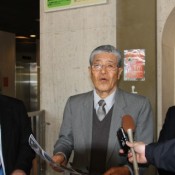
February 12, 2015 Ryukyu Shimpo
The Okinawa Defense Bureau is carrying out construction of a new base to replace Marine Corps Air Station Futenma in Henoko, Nago. Citizens protesting the construction, have continuously been injured by excessive force used by officers of the Japan Coast Guard (JCG). On February 12, a chairman of Nago City Assembly Minoru Yabiku and other assembly members visited the 11th Regional Coast Guard Headquarters. They asked the JCG to stop taking excessive actions against protesting citizens. The meeting was closed to the public.
Yabiku, deputy chairman of the assembly Zenko Nakamura, and Yoshitami Oshiro, a chairperson of Special Committee for Military Base Affairs in the assembly, denounced incidents in which coast guard officers injured citizens, using excessive force against them. They handed over a written opinion to the 11th Regional Coast Guard Headquarters to demand immediate cessation of landfill. According to Nakamura, Akira Namihira, a representative of the headquarters, said, “The coast guard officers take basic actions to remove the protesters by abiding by the law.” Yabiku said, “They superficially claimed the officers had dealt with the situation according to the law.”
Yabiku and the assembly member visited the Okinawa Prefectural Police and the Okinawa Defense Bureau to ask them to stop taking excessive action against protesting citizens.
(English translation by T&CT)
Go to Japanese

February 5, 2015 Kazuki Furugen of Ryukyu Shimpo
The Okinawa Prefectural Government (OPG) has estimated the economic effect of the future closure and return of the U.S. bases on Okinawa. This estimation highlights a possibility of economic growth as a result of the use of the lands returned from U.S. Military to owners. Closure and return of the Futenma base will produce 32 times more direct economic effect than is produced now by the base.
The returned lands in Kuwae and Kitamae area in Chatan have created 108 times more direct economic effect and those in the Shintoshin area in Naha have produced 32 times more. The OPG published a similar report in March 2007. This time, it has estimated economic effects using current statistics and reflecting municipalities’ policies for industrial vitalization.
The governments of Japan and the United States plan to return Camp Kuwae, camp Zukeran, Futenma Air Base, Makiminato Service Area and Naha Military Port to the owners. The lands of the five facilities will produce a combined effect of 18 times more direct economic benefit than now, the OPG estimates. Calculations on the economic ripple effect of the five facilities show that employment will increase from a current 4,400 jobs to 80,503, tax revenue from 5.7 billion yen to 100.4 billion yen. This equates to 18 times more tax revenue and employment than now.
The direct economic effect from the Futenma base is now 12 billion yen. The land that would be returned to the owners from U.S. military will bring a benefit of 386.6billion yen. The employment will increase by 32 times what it is now, from 1,074 to 34,093 jobs. The tax revenue will be 32 times more, from 1.4billion yen to 43 billion yen.
The direct economic effects from Kuwae and Kitamae areas in Chatan have increased to 33.6 billion yen from 300 million yen, when the lands were used for the U.S. military. The economic effects from the Shintoshin area in Naha have increased to 163.4 billion yen from 5.2 billion yen after the lands were returned. The total economic benefit in the three districts, including Kinjo and Oroku areas in Naha, has been 28 times that of when they were under U.S. military use, according to the OPG’s estimation.
An official from the OPG said, “The lands returned from the military produce huge economic effects. Early return of the U.S. bases and planning how to use them is important.”
(English translation by T&CT, Hitomi Shinzato)
Go to Japanese
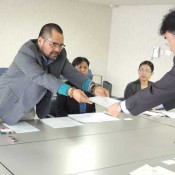
February 4, 2015 Ryukyu Shimpo
Yasukatsu Matsushima and three co-leaders of the Association of Comprehensive Studies for Independence of the Lew Chewans (ACSILs) visited Senior Coordinator Shunji Yamada at the Okinawa Office of Ministry of Foreign Affairs of Japan. They protested that the forced annexation of the independent nation of the Ryukyu Kingdom by Yamato (Japan) is an obvious violation of international law. The group demanded from the Japanese government an apology and “immediate cessation of the colonization of Ryukyu.” The delegates also requested retrocession of the original copies of three treaties between Ryukyu Kingdom and the United States, France, and the Netherlands, signed with each country during the 1850s. The Diplomatic Archives of the Ministry of Foreign Affairs of Japan is currently holding the treaties. The group members stated that these treaties were disregarded in the forced annexation of the Ryukyu Kingdom.
This is ACSILs’ first direct action taken against a government-related agency. Matsushima and co-leaders argue that Ryukyu was a sovereign nation at the time of annexation of the kingdom or the so called Ryukyu disposal in 1879, on the ground of the three treaties. The delegates further argue the “forced annexation” is a failing of article 51 under the Vienna Convention that forbids “Coercion of a Representative of a State.”
Matsushima and co-leaders also requested immediate cessation and cancellation of construction of a new military base in Henoko and helipads in Takae, Higashi. They argued that imposing an unreasonable U.S. base-hosting burden on Okinawa is discrimination against Ryukyuan people. The delegates plan to mail the request document to President Barack Obama. They will also mail a letter to ask the Okinawa Prefectural Government and the Prefectural Board of Education to create and expand opportunities to teach Ryukyuan history, nature, and language for students.
Matsushima and co-leaders held a press conference after the protest. They announced the delegates appeal to the United Nations to help them raise their voice against discrimination toward the Ryukyu, in collaboration with the indigenous people of Chamorro in Guam.
(English translation by T&CT and Sayaka Sakuma)
Go to Japanese
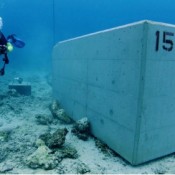
February 10, 2015 Ryukyu Shimpo
Concrete blocks, which the Okinawa Defense Bureau installed to secure floats and buoys, have hurt corals at several locations in Oura Bay, Nago. There, the governments of Japan and the United States are advancing work on a replacement facility for U.S. Marine Corps Air Station Futenma. Members of the Diving Team Rainbow of the Helicopter Base Objection Association confirmed this on February 1, 7, and 8.
“We may see dead corals next time, because they have been hurt so severely,” a member of the team said. They strongly condemned the construction work being carried out by the defense bureau.

An official from the fisheries division of the Okinawa Prefectural Government stated, regarding the damage to the corals, “The law does not require the procedures of prior consultation and permission to crush rock reefs, when the ships drop anchors. However, we will look into whether a new application from [ the defense bureau] should be required or not in this case.”
“I do not know where these photographs were taken,” an official of the defense bureau said. “We are not consulting with the prefectural government on this case, because they said last year the permission might not be necessary to install anchors to set floats within the construction zone.”
The members of Diving Team Rainbow have investigated five locations, including Abe and Sedake
Where large buoys and concrete blocks have been installed, the sea near the coast of Camp Schwab where large crane ships are anchored, and a channel nearby. There are concrete blocks weighing about 15-20 tons, sitting on coral rock on the seabed near Sedake and Abe. The coral rock was scraped and cut by the weight of the blocks.
Anchors installed to secure the buoys and floats have hurt the coral when waves dragged them during typhoons. One-hundred-and-twenty anchors have been lost so far. Environmental groups have warned against the installation of concrete blocks because it will compromise environmental protection and management.
(English translation by T&CT)
Go to Japanese

February 9, 2015 Ryukyu Shimpo
In relation to the U.S Marine Corps Air Station relocation to Henoko in Nago City, the Okinawa Defense Bureau has started installing large floating devices in Oura Bay. It began the work on the morning of February 9. Four ships and 14 kayaks carrying citizens protesting against the operation, penetrated an oil fence, which was installed to mark out the temporary restricted area.
The bureau used two large crane ships to start installing large floating devices into the sea. Small work ships towed and unloaded floating devices, which were placed between Nagashima and Henoko. The floating devices are twice as large as the currently installed ones. They are about 50 to 60 centimeters in diameter.
In front of the Camp Schwab gate, about 40 citizens held a protest rally. From 7 a.m., they started standing on the road, trying to prevent vehicles carrying the Japan Coast Guard staff from entering the camp. No scuffle broke out.
(English translation by T&CT)
Go to Japanese
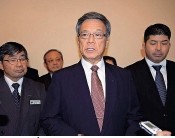
February 6, 2015 Ryukyu Shimpo
Members of the Council for the Promotion of Dezoning and Reutilizating Military Land in Okinawa visited the offices of Ministry of Foreign Affairs of Japan, Ministry of Defense, and U.S Embassy in Japan on February 5. They filed request documents asking the governments of Japan and the United States to move U.S Marine Corp Air Station Futenma outside of Okinawa. After assuming the office of Okinawa Governor, Takeshi Onaga formally asked for relocation of the base outside of Okinawa. It was the first time a governor had done so in writing. While the two ministers did not meet the delegate, administrative officers received the documents. Onaga has visited Tokyo six times since his accession to office last December. Although he visited the office of the Prime Minister on February 6, he could not meet with him. Instead, Deputy Chief Cabinet Secretary Kazuhiro Sugita met Onaga. Prime Minister Shinzo Abe and Chief Cabinet Secretary Yoshihide Suga, who is also the minister in charge of reducing U.S base hosting burden in Okinawa, will not meet him this time.
Koji Tomita, the head of the North American branch of the ministry met Onaga at the office of the Ministry of Foreign Affairs, while Akihiko Nakajima, director general of the Bureau of Local Cooperation met him at the office of the Ministry of Defense. Onaga said, “We would like the Japanese government to avoid Futenma Air Station becoming a permanent fixture, and work on moving the base outside Okinawa and returning the land it is now using. We also want the U.S and Japanese governments to stop the operation of the base within five years, and remove the dangers the base poses, as soon as possible.”
While Tomita said, “We have to avoid the base becoming a permanent fixture,” Nakjima replied, “The Henoko relocation is the only way to solve the issue.”
In his response to Nakajima’s reply, Nago Mayor Susumu Inamine said, “There were no reasonable grounds to relocate the base to Henoko. The way the Japanese government is forcing through the plan is terrible.” Inamine strongly criticized the security practices of the Okinawa Prefectural Police and Japan Coast Guard.
As well as Onaga and Inamine, five heads of municipalities in Okinawa took part in the delegation. However, Ginowan mayor Atsushi Sakima and Sachio Kuwae did not join because they did not support relocation of the base outside Okinawa. Onaga said, “Everyone takes their own unique stance, taking action while being in anguish over the issue. They are doing their best to fulfill their political goals.”
The council members visit Tokyo to see ministers and Prime Minister every year. In the last fiscal year, the Cabinet officials, including Abe met the delegate. There is a major difference between former Governor Hirokazu Nakaima and Onaga when it comes to the Japanese government’s treatment.
(English translation by T&CT)
Go to Japanese
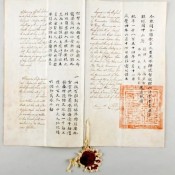
February 4, 2015 Tsuyoshi Arakaki of Ryukyu Shimpo
On February 27, the Urasoe City Museum exhibits three original copies of the Ryukyu Kingdom’s treaties of amity signed with the United States in 1854, with France in 1855, and with the Netherlands in 1859. These original copies were confiscated by the Meiji Government in May 1974 and held by the Ministry of Foreign Affairs. These original documents have crossed the ocean and will be exhibited in Okinawa for the first time in 141 years. International law specialists note that these original documents are evidence of Ryukyu’s sovereignty at that time under international law. In the midst of growing awareness of and requests for Okinawa’s rights to self-determination, especially regarding the U.S. military base issues, the homecoming of these treaties could influence discussions over Okinawa’s restoration of sovereignty.
The Ryukyu-U.S Treaty of Amity was signed with Commodore Perry, who came to Uraga (Kanagawa Prefecture) and the Ryukyu islands to pry open Japan, which had an isolationist policy at the time. Because of its bias towards the US, which offered special privileges such as providing water and firewood provision to the U.S ships and their consular jurisdiction, the Ryukyu government initially rejected the treaty. However, the kingdom eventually yielded to pressure from Commodore Perry and signed the treaty. The Ryukyu government later signed similar treaties with France and Holland.
Planning to annex the Ryukyu Kingdom and to deprive Ryukyu of its diplomacy after the Meiji restoration, the Meiji government ordered the kingdom to submit three treaties in March 1973. Although Ryukyu persistently resisted, they yielded to the tough stance of the Japanese government in the end. In May 1974, Chihwanuku Ueekata Shiishii went to Tokyo with three treaties and turned them over to the government. Currently, the Ministry of Foreign Affairs Diplomatic Archives possesses the original documents.
During the process of annexation by Japan, which is known as the Ryukyu disposal, the Ryukyu Kingdom claimed their sovereignty by signing these international treaties and presented them as a form of resistance to avoid annexation by the Meiji government.
Professor Hideaki Uemura of Keisei University and Professor Hiroyuki Abe of Kanagawa University pointed out that the Ryukyu was an independent actor under international law, not a part of Japan. The Meiji government besieged the Shuri Castle with its military and police and pressured King Sho Tai to agree on the establishment of Okinawa Prefecture. Pointing out that this action by the Meiji government amounts to “compulsion to representatives of a nation,” which the customary international law of the time prohibited, Uemura and Abe claim the annexation is illegal under international law.
The original copies of three treaties will be displayed at “the Okinawa Special Exhibition: the Ryukyu, the End of Edo, and the Meiji Restoration” at Urasoe City Museum from February 27 to March 29. The exhibit is sponsored by the Ryukyu Shimpo and the Cooperative Association Okinawa Industrial Project.
(English translation by T&CT and Megumi Chibana)
Go to Japanese
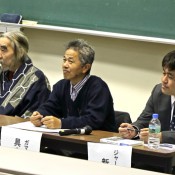
February 8, 2015 Ryukyu Shimpo
The Uruma-no-Kai held a symposium on the right of self-determination for Ainu and Ryukyuans at Okinawa International University in Ginowan on February 7. This group aims to strengthen solidarity with the Ainu people and is involved with planning an annual “Northern Territories Day”, which is on February 7. About 30 people took part in the symposium.
Panelist Tsuyosh Arakaki, a member of the Ryukyu Shimpo editorial board, spoke out about his ideas on self-determination for the Okinawan people. He gave a brief on the Scottish independence referendum held last year, showing photographs he took. “I think the people ‘s conscious ethnic identity is under the strong pressure of discrimination and forced assimilation,” he stated.
Takamatsu Gushiken, the president of the Gamafuya, a volunteer group dedicated to the recovery of human remains from the Battle of Okinawa, referred to the former practice of taking the bones of Okinawan and Ainu people out from their graves and preserving them for research purposes. “This shows the mainland people’s indifference to the Okinawa and Ainu people, that they thought such action against the Okinawan and Ainu people was permissible,” Gushiken said.
Kawamura Shinritsu Eoripakku Ainu, the director of the Kawamura Kaneto Ainu Museum in Asahikawa, and folk musician Shinya Mayonoka took part in the symposium as panelists.
(English translation by T&CT)
Go to Japanese
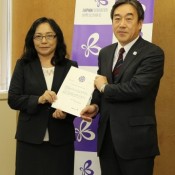
February 4, 2015 Ryukyu Shimpo
The Japan Foundation Prizes for Global Citizenship is an award that honors individuals and organizations working on international cultural exchange activities based in regions nationwide. The AmerAsian School in Okinawa has received the award this time. This is the second time Okinawan organizations have become recipients of the award since Ryukyukoku Matsuri Daiko in 1999.
The school, located in Ginowan City, teaches Amerasian students – students born in Asia to a U.S military father and an Asian mother – in both Japanese and English.
The principal and administrative director of the school Midori Thayer spoke at a press conference held in Okinawa Prefectural Government Office on February 4. Thayer said “I am honored the foundation recognized our continuous efforts over the past years. As a legitimate award recipient, we would like to help children with multinational backgrounds make a leap forward. I want to make those who have supported us, proud of our school.”
(English translation by T&CT)
Go to Japanese

February 7, 2015 Ryukyu Shimpo
Officers of the Japan Coast Guard (JCG) have been constraining citizens protesting against the plan to build an alternative base in Henoko, Nago, for Ginowan-based U.S. Marine Corp Air Station Futenma. On February 6, a spokesperson from the 11th Regional Coast Guard Headquarters announced that they would not respond to questions from the media on how and why these incidents occurred. The coast guard officers have been taking excessive actions against citizens protesting from kayaks. While some of the officers pushed the citizens from their kayaks into the ocean, others left them behind in the open ocean. Their actions have worsened. In anger, the citizens said that they would not tolerate such heavy-handedness, and warned it would prompt a protest from Okinawan people.
On that day, a reporter from the Ryukyu Shimpo asked the JCG to confirm reports that five citizens were constrained on on their kayaks outside of the restricted area. A representative of the 11th Regional Coast Guard Headquarters said, “We cannot answer individual cases on the issue.” When the reporter asked why they had previously been responding to verify the facts, but not now, the representative repeatedly said, “The answer is that we cannot answer to individual cases.”
The JCG had previously responded to questions from the media asking when and where incidents occurred, and confirmed the situations from coast guard officers at the scenes. When the Ryukyu Shimpo reporter asked about the incident where officers left citizens on their kayaks out in the open ocean, the representative of the JCG admitted the officers had moved the citizens offshore. The JCG representative said, “Officers dealt with the situation in terms of maritime safety and the law’s implementation.”
On February 2, the officers jumped onto a kayak carrying citizens and overthrew it. They then pushed them into the sea close to the area where ships and inflatable JCG boats were approaching. On January 20, a coast guard officer took excessive action against a 51-year-old female filmmaker Asako Kageyama by putting his leg on her shoulder and holding her body down with his weight in order to confiscate her camera. On January 30, the officers took away the paddle of a citizen on a kayak, throwing it in the ocean.
On February 6, Hiroji Yamashiro, the director of the Okinawa Peace Movement Center talked about the way the JCG did not respond to questions about its coast guard officers’ excessive actions against citizens. Yamashiro said, “They normally need to explain about what happened. Their attitude continues to prompt a protest from Okinawan people. The JCG is the same as the Japanese government which is ignoring Okinawan people’s will. It is unacceptable.” A college student from Tokyo, Katshiro Fujishiro said, “It doesn’t make sense that the JCG is not explaining about the coast guard officers’ excessive actions against citizens. I cannot tolerate that.”
(English translation by T&CT)
Go to Japanese












 Webcam(Kokusai Street)
Webcam(Kokusai Street)


